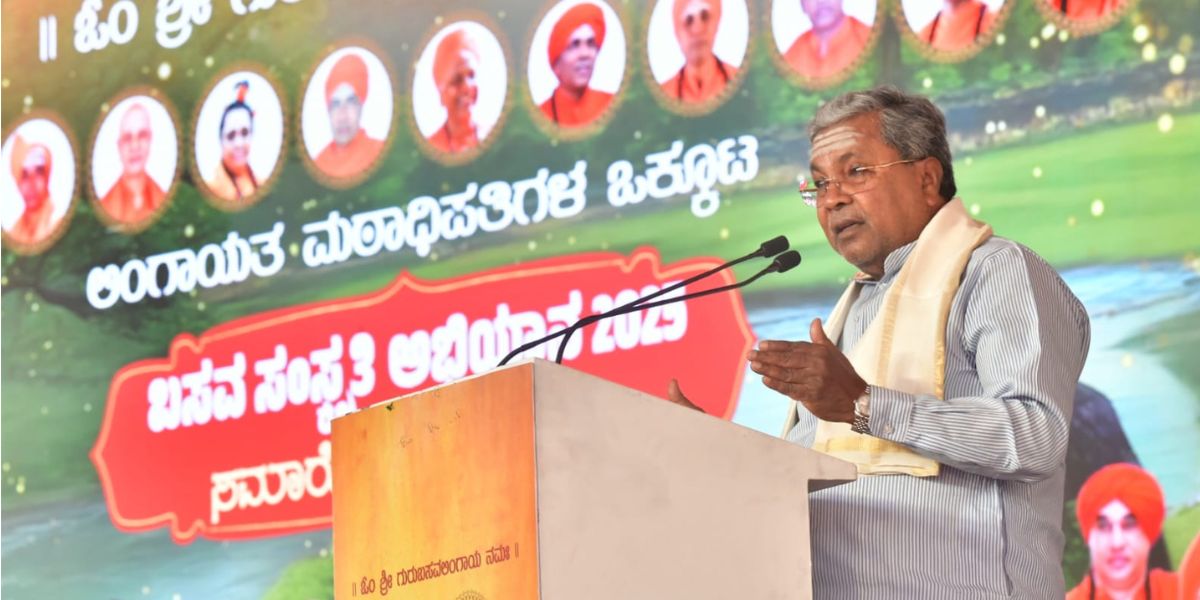The development also comes at a time when the Opposition BJP has been accusing the chief minister of dividing the Veerashaiva-Lingayat community with the ongoing socio-economic and educational survey.
Published Oct 06, 2025 | 11:21 AM ⚊ Updated Oct 06, 2025 | 11:22 AM

Siddaramaiah speaking during the closing ceremony of Basava Culture Campaign-2025.
Synopsis: In an apparent attempt to woo the Lingayat vote base, Karnataka Chief Minister said he would recommend renaming Namma Metro as Basava Metro. During an event, the community also demanded to recognise the Lingayat community as a separate religion.
In what is being seen as a step to bring the Congress closer to the dominant Lingayat community in Karnataka, Chief Minister Siddaramaiah on Sunday, 5 October, said he would recommend that the Union government rename Bengaluru’s Namma Metro as ‘Basava Metro’, after the 12th-century social reformer Basavanna.
The chief minister was speaking at the closing ceremony of the ‘Basava Culture Campaign-2025’ organised to mark the anniversary of ‘Vishwaguru Basavanna’ being declared as the ‘Karnataka Cultural Leader’ in the presence of seers and gurus of various Lingayat mutts.
“On the day of Basava Jayanti, when I took the oath as the chief minister, I resolved to fulfil Basavanna’s aspirations of providing equal opportunities for all to live,” Siddaramaiah said, adding that he has ensured opportunities for the poor of all castes and religions through welfare schemes and guarantees.
Apart from adding to the existing naming controversies around the metro project, the development also comes at a time when the Opposition BJP has been accusing the chief minister of dividing the Veerashaiva-Lingayat community with the ongoing socio-economic and educational survey.
“If this were entirely a state government project, I would have announced it as ‘Basava Metro’ today itself,” Siddaramaiah declared on Sunday.
The Karnataka Congress, led by Siddaramaiah, has been making efforts to woo the Lingayat community, especially during his current term as the chief minister.
In January 2024, the state Cabinet decided to declare the Lingayat social reformer Basavanna as Karnataka’s cultural leader, on the lines of Maharashtra making Chhatrapati Shivaji its icon. This was the first such declaration in Karnataka and adhered to a long-standing demand from prominent Lingayat pontiffs and seers.
In a statement, Siddaramaiah said, “I am satisfied that our government has fulfilled this demand. I hope all pontiffs will bless our government.” The move came ahead of the Lok Sabha elections and a couple of months after the Lingayats and Vokkaligas rejected the earlier socio-economic and education survey (2015), claiming underrepresentation of their respective communities.
In February 2024, Siddaramaiah directed district in-charge ministers, MLAs at the taluk level, and the respective chairpersons in all urban and rural organisations to place Basavanna’s portrait in all government offices across the state.
The chief minister referred to both these initiatives during the event on Sunday.
“I am an admirer of Basavanna. I have faith and commitment to the principles of Basava. My belief is that Basava’s principles are eternal and relevant — not just in the past, not just today, but forever. Basavanna preached coexistence and tolerance throughout his life, and I follow this as well,” he said. Due to these reasons, the chief minister said, he made it mandatory to place Basavanna’s portrait in all government offices.
“By declaring him the cultural leader of Karnataka, the entire government has paid tribute to Basavanna,” he added.
Large and Medium Industries Minister MB Patil, who was also present at the event, said the Lingayat community should stand by Siddaramaiah since he had contributed to the development of the community more than anyone else.
Considered a traditional support base of the BJP, a section of the Lingayat community had been demanding a separate religion status (only for the Lingayats and not the Veerashaiva-Lingayats).
One such decision of the Congress, with the intent to woo the community, had backfired in 2018.
Although the erstwhile Siddaramaiah government accorded minority religion status to the Lingayat community in 2018, the move was believed to be one of the major reasons why Congress failed to retain power that year.
It was seen as an attempt to divide the Hindu community and the Veerashaiva-Lingayat community, and claims emerged that Siddaramaiah decided to make a distinction between the groups.
While one section led by Akhila Bharata Veerashaiva Mahasabha had demanded separate religion status, asserting that Veerashaiva and Lingayats are the same, the other group wanted it only for Lingayats, as they believe that Veerashaiva is one among the seven sects of Shaivas, which is part of Hinduism.
The rifts within the community were visible during the event on Sunday, too. While Congress leaders, including MB Patil, Sharan Prakash Patil, and Laxmi Hebbalkar, among others, participated in the event, ministers and leaders who are associated with the Akhila Bharatha Veerashaiva Mahasabha and its office-bearers kept away.
However, the demand for a separate religion resurfaced at the event with the Lingayat Matadeeshara Okkoota adopting five resolutions in the presence of the chief minister. One of the resolutions was the need for a separate religion status for Lingayats.
Stating that Lingayat religion is the greatest religion founded by Mahatma Basaveshwara and other Sharanas in the 12th century, the resolution said, “Geographically, we are all Hindus. Continue to raise awareness for religious recognition so that Lingayats get government benefits and reservation facilities like Buddhists, Jains and Sikhs.”
The demand has come up at a time when Veerashaivas and Lingayats are seeking a separate religion under the ‘others’ column in the ongoing socio-economic and educational survey. While bodies representing the Veerashaiva-Lingayat community urged members to enumerate themselves as Veerashaiva-Lingayats, other factions representing the Lingayats pushed for solely registering as ‘Lingayat’ in the census.
The fight for nomenclature has caused confusion and exposed the long-standing fault lines in the community.
(Edited by Muhammed Fazil.)
